Saturday, 14 August 2004
Leave from Merak Harbour
GPS: 5° 56.7' S 106° 00.0' E
[Natascha >>]
We leave Merak Harbour around 3 pm.
Now that the engine works, there is no reason whatsoever to stay in this ugly
industrial city any longer. Up to the white beaches and Cocos trees. Cocos Keeling,
here we come! Approximately 650 miles to go which will probably take 5 days -
depending on the wind.
We talked to John Potter on Jocara
earlier today on the HF radio. John and Caroline were the ones who convinced us
that sailing around the world is actually possible for normal breathing people
and not just reserved for a bunch of idiots. When we first explored the idea,
they gave us a very balanced view of what cruising would be like and we must say,
they have been right so far. They are now on our trail towards the Indian Ocean
where they will spend a year cruising with their two kids Casper and Alex. They
‘lived’ opposite to us in the RSYC in Singapore and went to similar issues when
preparing the boat. We recommended Winston to them for the paintwork and they
went through exactly the same issues with him as we did. Looking forward to seeing
them again in the habitat where we did it all for – a nice tropical island far
away from civilization and the accompanying hassles of live.
[<< Natascha]
[Stefan >>]
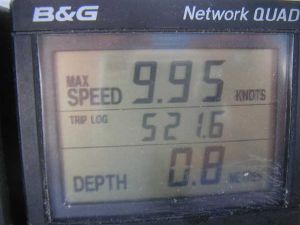 We
got hit by 25 knots on a beam reach which asks for a second reef in the main.
A smaller genoa would also be welcome, but that's out of the question in the dark
in these conditions. It’s going to be a bumpy night. We are constantly racing
above hull-speed doing 9 knots and more – we clock a maximum speed of 9.95 knots.
This is as much fun as racing my old Porsche at 250 kph and though not illegal,
probably as risky if you don't know what you're doing. But Espiritu seems to enjoy
it and screams about, happily ignoring her beaten-up crew. We
got hit by 25 knots on a beam reach which asks for a second reef in the main.
A smaller genoa would also be welcome, but that's out of the question in the dark
in these conditions. It’s going to be a bumpy night. We are constantly racing
above hull-speed doing 9 knots and more – we clock a maximum speed of 9.95 knots.
This is as much fun as racing my old Porsche at 250 kph and though not illegal,
probably as risky if you don't know what you're doing. But Espiritu seems to enjoy
it and screams about, happily ignoring her beaten-up crew.
Please ignore the 0.8 meters on the depth sounder – it
gets a bit confused if the depth exceeds 50 meters and starts reading funny measures.
The actual depth is 4000 – 5000 meters, we are now truly ‘deep blue’.
[<< Stefan]
Sunday, 15 August 2004
Indian Ocean
GPS: 7° 02.7' S 104°
20.0' E
[Natascha >>]
The wind backed of a bit to 20 knots
and we are still sailing FAST! To be more comfortable we slowed her down to 7.5
knots, but at each gust she keeps on accelerating to 8 to 9 knots. Similar winds
are predicted for the coming 250 miles, increasing to 25-30 knots with 4-5 meter
waves around Cocos Keeling itself.
Time to get around with changing the headsail to the genoa
no.2. Main challenge is getting down the no.1, which measures 70 m2.
To avoid it from escaping we literally crawl over the sail as we lower it and
we manage to roll it in a big messy bundle that we drag aft to the cockpit. If
you think of the 3 meter waves that occasionally crash over the bow you can imagine
we were quite exhausted when we got it down in the cabin.
Then back to the bow with the no.2 two under our arms
to put that up. One of the toughest parts is putting the shackles on while being
drowned in the waves. If you let go of a part it’s gone and you can go back to
get a spare. But none of that happens and we look quite satisfied at the no.2
after an hour of hard work.
We clocked 180 miles in the first 24 hours! Bravo for
Espiritu.
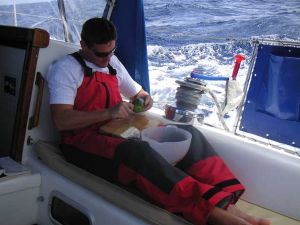 Monday
16 August 2004 Monday
16 August 2004
Indian Ocean
GPS: 8° 58.0' S 102° 38.0' E
The night is not very relaxed with a gusty wind, rain
and many waves crashing over the boat. Spoiled as we are, used to sailing in 30
degrees in a t-shirt, we are getting quite cold and start looking for the gore-tex
sailing trousers.
The wind laid down to 16 knots giving us a bit of a rest
after a night of racing. Not for long though as it increased to 20 knots again
pushing the boat to over 8 knots per hour. We clocked 157 miles in the second
24 hours.
Tuesday, 17 August 2004
Indian Ocean
GPS: 10° 12.3' S 100° 41.2' E
"Beep Beep". "What's that? The Iridium
telephone?" Hey that's nice, receiving sms messages from my sister and Stefan's
parents in the middle of the ocean. Too bad we can’t return via sms, but we do
like receiving them. You can send them at no charge via the website http://www.iridium.com.
Our phone number is +88 163 154 7736.
As predicted, the wind increased further to the promised
30 knots and the waves also reached their intended 5 meters. We put a third reef
in the main and furl the genoa a bit further to about the size of the storm sail.
We keep on racing and cover a record mileage of 189 miles in 24 hours. Would be
nice if we can beat the 200 once, but let’s save that till we know the boat a
bit better which will make us more comfortable driving her hard. For the time
being we are more than satisfied with the day-time arrival at Cocos Keeling tomorrow.
[<< Natascha]
Wednesday, 18 August 2004
Arrival at Cocos Keeling
GPS: 12° 04.8' S 97° 35.6' E
It’s six in the morning and I'm finishing
my last night watch for the coming weeks. Only 50 more miles to go to Cocos Keeling.
The wind back to the East even more which makes us running dead down wind, which
is not that uncomfortable as long as the wind keeps blowing. As soon as it lays
down a bit the sails start flapping which is a bit annoying. Time to get the third
reef out as soon as Stefan comes up again.
[<< Natascha]
[stefan >>]
Bang! The main sheet came of the boom because the connection between the block
and the shackle turned itself loose. So we found ourselves in 30 knots of wind,
in 5 meter waves, doing 8 knots, with a boom that hung freely next to the boat.
There was no way to reach the end of the boom without climbing on it, for which
I had no appetite at all. Time to get creative. I managed to throw a line over
the boom and after some jiggling with the boat hook pulled it around the third
reef line. Put a Boolean knot in and we had a connection again. Led this via the
aft cleat to a winch and the main was back in business.
[<< Stefan]
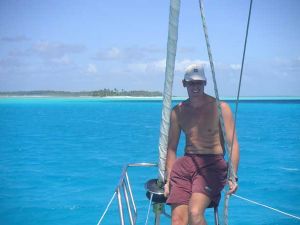 [Natascha
>>] [Natascha
>>]
Land ahead! We see the first contours of the islands with its palm
trees at noon, about 9 miles before we reach there. The coming hour we sit there
fascinated over the feeling of reaching a remote island after sailing there ourselves.
The color of the water changes suddenly from deep blue to turquoise, indicating
the water gets shallower reaching to about 20 meters.
We navigate through the reefs to the yellow quarantine
mooring where we wait for the customs to arrive. We are heavily impressed by the
surrounding; beautiful white beaches, sparkling light blue water in which we can
see small sharks swimming. The island in front of us has numerous palm trees –
this is what you see on these postcards. There are about 10 other boats swinging
on their hooks. Although we are not supposed to leave the boat we can’t resist
diving into the water to refresh ourselves. The sharks don't even bite-:).
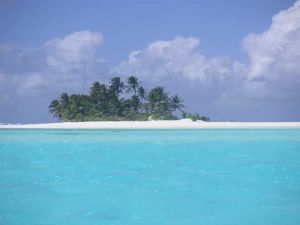 A
little dinghy with two frantically waving people is approaching us, shouting Scheveningen,
Scheveningen. It's Cees and Karola de Reus who used to live in Scheveningen and
left with their Borracho 7 years ago. A
little dinghy with two frantically waving people is approaching us, shouting Scheveningen,
Scheveningen. It's Cees and Karola de Reus who used to live in Scheveningen and
left with their Borracho 7 years ago.
We heard all kind of horror stories about Australian customs
that you take all your fresh food away, including the meat we have in the freezer
and don't forget the 3kg Parmesan cheese. We decide to hide some stuff in sailing
bags and hope the best of it.
None of that. The customs guy is totally relaxed – no
worries – and kindly asks us not to bring any of our food on land and burn all
litter we have. Sure – no worries mate. In hindsight, we should have stuffed that
bloody freezer all the way with food, but hey, who could have expected this.
The daily 5pm drinks at the beach went down very well
and at 9 pm we where in a deep sleep.
 Thursday,
19 august 2004 Thursday,
19 august 2004
Cocos Keeling
GPS: 12° 05.5' S 96° 53.0'
E
The beautiful atoll of Cocos
Keeling has currently 140 mostly Australian people and another 500 Malay people
living on it. Apart from the other uninhabited islands, three islands are of interest.
Direction Island where we are anchored, Home Island, where most of the Malay live
and West Island, the administrative center, where most of the Australians live.
The facilities on both inhabited islands are however limited.
We took the dinghy to Home Island - which is 1.5 miles from Direction Island -
to get Australian dollars, buy some food and we actually managed to find an internet
cafe with fairly quick connections.
So what do you do in paradise? Diving? Swimming? Kite
surfing? Fishing? None of that. The boat was a total mess and, as mentioned earlier,
not as waterproof as we hoped it was. So it was time to start drying out wetted
lockers, wipe off rusted cans and aaargh, the aft cabin had again some diesel
in it. It was only a little bit which means it cannot be a true leak as only a
minor crack will already spill liters a day. Stefan tightened the hose clamps
a bit further hoping that this would resolve the issue. The only way to find out
is bring the boat on a heel again and see if it stays dry now.
[<< Natascha]
Friday, 20 August 2004
Cocos Keeling
GPS: 12° 05.5' S 96° 53.0'
E
[Stefan >>]
Took my kite board out of its bag for
the first time in nearly two years time. I got myself a second, larger kite on
the last trip to the Netherlands to avoid sitting around at the beach in too light
air. Should Natascha want to give it a try one day, we at least have two kites
- it's all a matter of selling it to the misses… No wind-worries for today, as
it was blowing 25 knots, which was just fine to get me going.
Starting and pointing into the wind went remarkably well.
The feeling got back to me in a matter of minutes. Also gybing went pretty cool,
so with 10 people on shore watching, time to throw in the better stuff. The first
attempt didn't quite work, but on the second attempt I launched myself about 3
meters in the air, getting ready to have a smooth landing some 15 meters down
the wind. That landing did not qualify as such at all, in fact, it was a complete
wipe-out. Getting smashed into the water was one, having the kite abruptly pulling
on your trapeze vest, which hook planted itself nicely into my ribs was the rather
unpleasant other. Does it hurt? Well only when I laugh… You fool.
[<< Stefan]
[Natascha >>]
 Each
Friday there is a so-called "pot-luck" on the beach whereby everybody
brings some food for the barbecue. We meet Hans, a 44-year old Swede who sails
solo on his 40 foot steel yacht Born Free. Started in Sweden with his girlfriend
who jumped from board in Brisbane. Born free and free again! Each
Friday there is a so-called "pot-luck" on the beach whereby everybody
brings some food for the barbecue. We meet Hans, a 44-year old Swede who sails
solo on his 40 foot steel yacht Born Free. Started in Sweden with his girlfriend
who jumped from board in Brisbane. Born free and free again!
There is a fun group of three South-African boats who
are now close to finishing their 3-year round the world trip. This to the great
relief of Verona, one of the wives who has been constantly seasick. She loves
being underway, but hates the sea as she turns sick right after they leave port.
All she does is the night-watch to enable John to sleep a bit. But she won't cook
and if something needs attention she will call John. Well, it's a way of getting
around the world. I'm just happy that I'm getting over my seasickness and can
enjoy the actual sailing. Talking to the South-Africans is quite fun as we can
understand Afrikaans which is quite similar to Dutch. Add the language / culture
related directness and sense of humor and you get to some pretty sick jokes. Had
a good laugh.
The Brazilians Christian en Fernanda are the youngest
- both under 30 - and they left 5 years ago. Fernanda was only 22 when they sailed
off and she wouldn't know what to do when they arrive in Brazil in 6 months time.
Probably rob a bank and sail off again - that brilliant idea came up after plenty
of whisky and wine. Never mind next morning.
Saturday, 21 August 2004
Cocos Keeling
GPS: 12° 05.5' S 96° 53.0'
E
Hans turns up at 10 am asking if we want to go snorkeling
at a shallow wreck called Catalina, which is about 20 minutes with the dinghy.
We were actually still fast asleep, but what the hell, the water will wake us
up. We leave with 4 dinghies; Hans, Christian & Fernanda, and the South-Africans
Clive, John and Verona. The wreck is just perfectly situated. At only 3 meters
deep in extremely clear water with plenty of coral grown onto it that gives good
feeding grounds to all kind of fish. Just fantastic. We split the way back by
jumping in the water again over another, slightly deeper coral reef. John and
Clive have spear-guns to shoot fish if a barbecue suitable one swims by. If you
do shoot something you have to throw it very quick into the dinghy as three black-tip
sharks are circling around you ready to snatch it of your gun. They are generally
not aggressive, but I would rather not fight with them over a piece of fish.
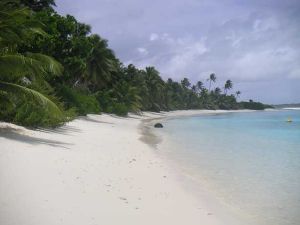 We
are quite happy meeting this nice group of people who we will probably see a lot
more on the trip ahead. We will certainly see the Brazilians and South-Africans
up until their home grounds and some others are actually making it all the way
to Europe via similar routes. From here to South-Africa the group will split in
two directions; north of Madagascar to Chagos and the Seychelles, and south of
Madagascar via Rodrigues, Mauritius and Réunion. The second route is shorter and
gives you maximum benefit from the trade winds but has the disadvantage of a rougher
approach to South-Africa. It will also surpass Chagos, which is supposed to be
the ultimate paradise only accessible by sailing boat, where you can always fly
to Mauritius. Better check the pilot charts with the wind roses again before we
make up our mind. We
are quite happy meeting this nice group of people who we will probably see a lot
more on the trip ahead. We will certainly see the Brazilians and South-Africans
up until their home grounds and some others are actually making it all the way
to Europe via similar routes. From here to South-Africa the group will split in
two directions; north of Madagascar to Chagos and the Seychelles, and south of
Madagascar via Rodrigues, Mauritius and Réunion. The second route is shorter and
gives you maximum benefit from the trade winds but has the disadvantage of a rougher
approach to South-Africa. It will also surpass Chagos, which is supposed to be
the ultimate paradise only accessible by sailing boat, where you can always fly
to Mauritius. Better check the pilot charts with the wind roses again before we
make up our mind.
[<< Natascha]
Sunday, 22 August 2004
Cocos Keeling
GPS: 12° 05.5' S 96° 53.0'
E
[Stefan >>]
Yesterday's snorkeling triggered our
diving senses so time to get down to the serious stuff. We take the tanks out
and head off to a place called "Rose Wall" that has a diving sign. Must
be good.
John and Hans join in John's dinghy which gives us two
boats, which is rather reassuring if one of the engines fails. Rowing back for
2 miles against 20 knots of wind is not really an option and the next stop is
probably Chagos, 1500 miles further. We jump in the water, hoping for heaps of
sharks and other big stuff. Too bad, nothing there over 50 centimeters. Never
mind, the coral is nice enough and it feels good to dive again.
We spend the afternoon toying around with the Chagos versus
Mauritius debate. A combination is not advisable since the route from Chagos to
Mauritius will be to wind-ward and against the southerly swell. One of the other
boats did the trip two years ago and they experienced free-falls from 9 meter
waves with their 20 tons, 40 foot steel boat. Given that we are almost twice as
light, the ride will be even bumpier for us. I'm sure we'll survive it, but why
invite trouble?
[<< Stefan]
Monday, 23 August 2004
Cocos Keeling
GPS: 12° 05.5' S 96° 53.0'
E
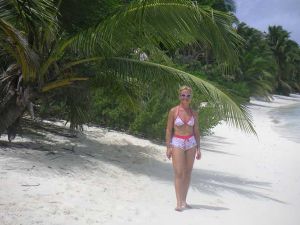 [Natascha
>>] [Natascha
>>]
The three South-African boats left this
morning for Chagos. They also got waived out by a small group of dolphins - quite
nice of them to arrange such a farewell.
The Iridium phone continues beeping over all the sms
messages. This time from my sister and Monique and Ernst. Thanks guys, it's
just too bad we can't return your messages. It also seems we can't receive inbound
calls, just make outbound calls ourselves. The Iridium network is primarily intended
to make outbound calls, although inbound calls should be possible. Anyway, we
can call if we want to and can be reached if needed so what are we complaining
about? We also very much appreciate all emails and messages in the guest book
on the website. You wouldn't imagine it, but we do think a lot about our family
and friends up here.
[<< Natascha]
[Stefan >>]
The solar panels give far less current
than they are supposed to - only 2 amps between the four of them, which should
be delivered by each of them individually. First checked the connections to the
batteries moved on to the panels itself. After disconnecting them one after another,
I found what was wrong. One of them had a blown fuse and another was connected
the wrong way around, which now actually worked against its two remaining brothers.
Four minus one gives three, three minus two times one gives one. Still with me?
So connected them all properly and there was my full 10 amps. That wasn't too
hard.
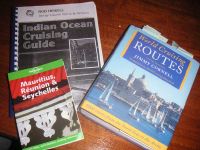 It
rained almost all day so all the time to check C-map, Visual Passage Planner,
Jimmy Cornell's World Cruising Routes, the Indian Ocean Pilot and the Lonely Planets
to decide on the choice Rodrigues/Mauritius/Réunion, versus Chagos/Seychelles/Comoros.
We already excluded the combination Chagos/Mauritius which makes life a bit easier.
Both options are fairly relaxed for the first part, the fun part will come when
reaching South-Africa. It
rained almost all day so all the time to check C-map, Visual Passage Planner,
Jimmy Cornell's World Cruising Routes, the Indian Ocean Pilot and the Lonely Planets
to decide on the choice Rodrigues/Mauritius/Réunion, versus Chagos/Seychelles/Comoros.
We already excluded the combination Chagos/Mauritius which makes life a bit easier.
Both options are fairly relaxed for the first part, the fun part will come when
reaching South-Africa.
The Mauritius option follows the south-coast of Madagascar
which offers gales on the nose every 2 to 3 days. This can be quite vicious with
waves that grow very rapidly due to the warm Indian Ocean water that confronts
the cold Arctic stream. Jimmy Cornell says that many sailors regard this stretch
as the toughest leg of their entire round the world trip and highly recommends
preparing the boat thoroughly. That should be warning enough.
The Chagos option brings you along the north-coast of
Madagascar which also has a reputation to keep up when it comes down to foul weather.
Big plus here are the numerous islands where you can seek shelter if the shit
hits the fan. You just wait for the next weather window before leaving again.
So sailing-wise, the Chagos route seems preferable, despite the 800 extra miles.
But then, that's probably no more than 5 days so what are we talking about?
When looking at the destinations, Chagos and the Seychelles
are favorable for diving and deserted wild-life. Rodrigues and Réunion on the
other hand have great hiking possibilities. It's like comparing apples and oranges,
but the more we think of it, the more weight the diving gets, especially because
that hasn't been that good so far. Too be continued………
[<< Stefan]
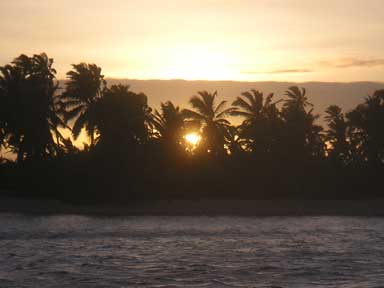
|


